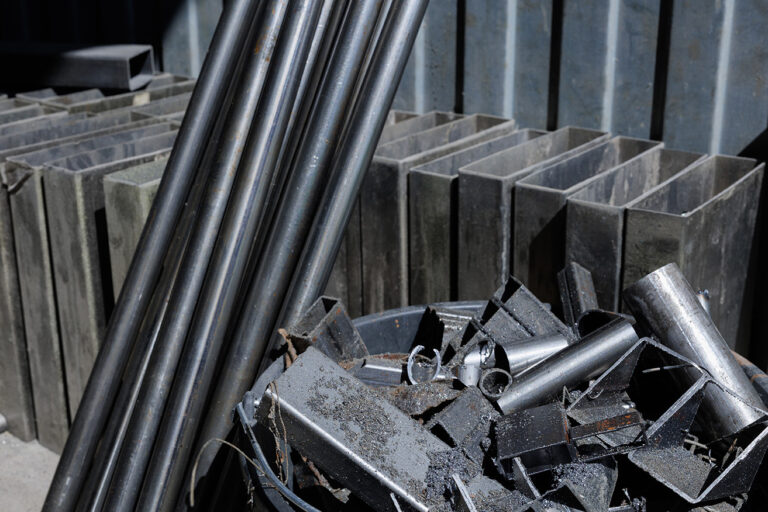Understanding Metal Recycling
Metal recycling is a process that breathes new life into used metals, transforming them into valuable resources once again. This process involves collecting, sorting, and processing metals that have reached the end of their life cycle in products and repurposing them for new uses. The significance of this process lies in its ability to conserve natural resources, which are often limited and non-renewable.
Metals are among the few materials that can be recycled repeatedly without degradation of their properties. This unique characteristic makes metal recycling a powerful tool in resource conservation. By recycling metals, we reduce the need to mine and process virgin materials, which involves extensive energy consumption and environmental degradation. The recycling process typically consumes less energy, emits fewer greenhouse gases, and uses less water compared to the mining and processing of new metals. This not only conserves the energy but also minimizes the environmental footprint of metal production.
The Importance of Metal Recycling in Business
For businesses, metal recycling transcends being a mere environmental gesture; it is a strategic decision with multiple benefits. Firstly, it can lead to significant cost savings. Recycled metals are often less expensive than virgin metals, as the cost of recycling is generally lower than the cost of extraction and processing of new metals. This cost-effectiveness can be a game-changer for businesses that rely heavily on metal for their products, allowing them to reduce production costs and increase profitability.
Metal recycling can substantially enhance a business’s brand image. In an era where consumers and stakeholders are increasingly conscious about environmental sustainability, companies that actively engage in and promote recycling efforts are viewed more favorably. This enhanced reputation can lead to increased customer loyalty, better brand recognition, and even open up new markets that prioritize sustainability.
Furthermore, engaging in metal recycling can help businesses comply with environmental regulations and standards, reducing the risk of penalties and legal issues. It also positions a company as a responsible member of the community, which can be beneficial for public relations and local community relations.
Businesses that incorporate metal recycling into their operations often find themselves at the forefront of innovation. The need to efficiently collect, sort, and recycle metals can drive technological advancements and process improvements. This not only benefits the recycling aspect of the business but can also lead to overall operational efficiencies.
Lastly, metal recycling is a key component in the global movement towards a circular economy, where waste is minimized, and resources are reused and recycled. By participating in this movement, businesses contribute to a more sustainable economic system, which is increasingly being recognized as crucial for long-term environmental and economic health.
Metal recycling offers a multitude of advantages for businesses. It is not just an environmentally responsible practice but also a strategic decision that can lead to cost savings, improved brand image, compliance with regulations, innovation, and participation in the global shift towards a circular economy. As the world increasingly recognizes the importance of sustainability, metal recycling stands out as a key practice for businesses aiming to reduce their environmental impact while enhancing their economic viability.
The Environmental Benefits of Metal Recycling
Reducing Greenhouse Gas Emissions
One of the most significant environmental benefits of metal recycling is the substantial reduction in greenhouse gas emissions. The process of extracting and processing virgin metals is energy-intensive and involves burning fossil fuels, which releases a large amount of carbon dioxide and other greenhouse gases into the atmosphere. These emissions are major contributors to climate change and global warming.
In contrast, metal recycling is a much less energy-intensive process. It bypasses the need for mining, ore processing, and metal refining, all of which are stages that contribute heavily to greenhouse gas emissions. For instance, the recycling of aluminum involves melting down scrap aluminum, a process that requires far less energy than extracting aluminum from bauxite ore. This reduced energy consumption directly translates into a decrease in greenhouse gas emissions. According to the Environmental Protection Agency (EPA), recycling metal may reduce greenhouse gas emissions by up to 300 million tons each year.
Conservation of Resources
Metal recycling plays a crucial role in conserving finite natural resources. Metals are non-renewable resources, meaning they do not replenish at a rate fast enough to be considered sustainable for ongoing extraction. Once depleted, these resources cannot be replaced. Recycling metals helps to ensure that the existing supply of metals is used more efficiently and remains available for future generations.
By recycling metals, we reduce the need to mine new metal ores. Mining not only depletes natural resources but also leads to various environmental issues, such as soil erosion, loss of biodiversity, and contamination of soil, groundwater, and surface water by chemicals from mining processes. Metal recycling mitigates these environmental impacts by lessening the demand for new mining activities.
Energy Savings
The energy savings associated with metal recycling are substantial. Producing metals from recycled materials often requires significantly less energy than producing them from virgin ore. For example, recycling aluminum saves about 95% of the energy required to make the same amount of aluminum from its virgin source, bauxite. Similarly, recycling steel saves 60-74%, recycling copper saves 85%, and recycling lead saves at least 65% of the energy compared to primary production.
These energy savings are primarily because the extraction process, which includes mining, transporting, and refining ore, is much more energy-intensive than the process required to recycle the same material. The energy conserved by recycling can be substantial. For instance, the energy saved from recycling one aluminum can is enough to run a television for three hours.
Moreover, the energy saved by recycling metals can be redirected to other industries or domestic consumption, contributing to a more efficient and sustainable energy use pattern. This is particularly important in the context of growing global energy demands and the need to transition to renewable energy sources.
The Economic Impact of Metal Recycling
Cost Efficiency
The economic advantages of metal recycling are substantial, particularly in terms of cost efficiency. Using recycled metals can often be more cost-effective than utilizing new metals, a factor that can lead to significant savings for businesses across various industries. This cost-effectiveness is due to several factors:
- Lower Production Costs: The process of recycling metals is generally less expensive than extracting and processing virgin ores. The reduced costs are attributed to the lower energy requirements of recycling, as well as the bypassing of the more labor- and capital-intensive stages of mining and refining.
- Stable Supply and Pricing: Recycled metals can provide a more stable supply chain, as they are less impacted by the geopolitical and economic issues that often affect the mining industry. This stability can lead to more predictable pricing, which is advantageous for budgeting and financial planning in businesses.
- Reduced Environmental Compliance Costs: Businesses using recycled metals may face lower costs related to environmental compliance, as recycling typically has a smaller environmental footprint than virgin metal production. This can translate into savings on permits, environmental management systems, and potential penalties associated with environmental degradation.
- Revenue from Waste: For companies producing metal waste, engaging in recycling not only reduces waste disposal costs but can also turn a cost center into a revenue stream. Selling scrap metal to recyclers can provide an additional income source, offsetting operational costs.
Job Creation
The metal recycling industry is a significant job creator, contributing to employment in several sectors:
- Collection and Sorting: This sector involves jobs in the collection of scrap metal from various sources, including industrial, commercial, and residential. Workers are also needed for sorting metals, a critical step in ensuring the quality and purity of the recycled product.
- Processing: The processing of recycled metals requires a workforce for operating machinery to shred, melt, and purify metals. These processes are labor-intensive and require skilled operators.
- Manufacturing: Recycled metals are a raw material for manufacturing a wide range of products. This creates jobs in manufacturing industries that use recycled metals, from automotive to construction and electronics.
- Support Services: The recycling industry also generates employment in support services, including transportation, equipment maintenance, and environmental monitoring and compliance.
- Innovation and Technology Development: As the industry evolves, there is a growing need for professionals in areas such as research and development, engineering, and environmental science to develop more efficient recycling technologies and processes.
The economic impact of metal recycling extends beyond direct cost savings and job creation. It stimulates economic activity in related sectors, contributes to the development of green technologies, and supports the transition to a circular economy. By reducing reliance on virgin materials, it also helps stabilize global metal markets, making them less susceptible to the volatility of resource extraction industries.
How Metal Recycling Works
Collection and Sorting
The journey of metal recycling begins with the crucial steps of collection and sorting, which lay the foundation for the entire recycling process. These steps determine the efficiency and quality of the recycled metal.
- Collection: The collection of scrap metal comes from various sources, including industrial waste, consumer products, end-of-life vehicles, construction debris, and electronic waste. This collection can be conducted by local governments, private waste management companies, or specialized scrap collectors. Businesses and industries often have dedicated programs for collecting scrap metal.
- Sorting: Once collected, the metals must be sorted. This step is vital because different metals require different recycling processes. Sorting can be done manually or with the help of advanced technologies like magnetic separation, eddy current separation, and infrared sensors. Magnetic separation is particularly effective in separating ferrous metals (which are magnetic) from non-ferrous metals. Eddy current separators are used to separate non-ferrous metals like aluminum and copper from other materials.
- Preparation: After sorting, metals may undergo additional preparation before processing. This can include dismantling complex items like cars or appliances to remove non-metal components, or cutting large pieces of metal into smaller, manageable sizes.
Processing and Purification
Once the metals are collected and sorted, they move on to the processing stage, which involves several steps to prepare them for recycling and eventual reuse.
- Shredding: The first step in processing is often shredding, where metal is broken down into smaller pieces. This increases the surface area of the metal, making it easier to process and melt. Shredding also aids in the removal of impurities and helps in more efficient melting.
- Melting: The shredded metal is then melted in a large furnace. Each metal has a specific melting point, and the furnaces are set accordingly. Melting consumes energy, but it is significantly less than the energy required to produce metal from ore. The melting process can take anywhere from a few minutes to several hours, depending on the volume and type of metal.
- Purification: After melting, purification is necessary to ensure the quality of the metal. Different methods are used for purification, such as electrolysis or the use of an electrochemical process. The choice of purification method depends on the type of metal and the desired quality. For example, aluminum is purified using the Hall-Héroult process, which involves dissolving the aluminum oxide in molten cryolite and then electrolytically reducing the aluminum.
- Solidifying: Once purified, the molten metal is carried in conveyor belts to cool and solidify. During this stage, the metal can be formed into specific shapes like bars, sheets, or coils, depending on its intended use.
- Transportation to Manufacturers: After the metal has solidified, it is transported to various manufacturers who will use this recycled metal to produce new products. This closes the recycling loop, as the metal that was once waste is now ready to be used again in the production cycle.
The process of metal recycling is a fine example of a circular economy, where waste is minimized, and materials are continually reused. This process not only conserves natural resources and energy but also reduces greenhouse gas emissions, making it an environmentally and economically beneficial practice. By understanding and improving each step in this process, from collection and sorting to processing and purification, we can enhance the efficiency and effectiveness of metal recycling.
Manufacturing New Products
Once the recycled metals have been processed and purified, they are ready for the final stage in the recycling loop: manufacturing new products. This stage is where the true value of metal recycling comes to fruition, as it demonstrates the practical application of recycled materials in everyday life.
Utilization in Various Industries
- Construction Industry: Recycled steel and iron are extensively used in the construction industry for building frames, reinforcements, and infrastructure. The durability and strength of these metals make them ideal for such applications.
- Automotive Industry: The automotive industry relies heavily on recycled metals, particularly aluminum and steel, for various components such as engines, body parts, and frames. Recycling metals in the automotive industry not only reduces manufacturing costs but also lightens the weight of vehicles, improving fuel efficiency.
- Electronics and Appliances: Recycled metals like copper and aluminum are crucial in manufacturing electronic appliances and components due to their excellent conductivity and heat resistance. Copper, for instance, is widely used in wiring, circuit boards, and batteries.
- Packaging Materials: Aluminum is a popular choice for packaging materials, especially in the food and beverage industry, due to its lightweight and resistance to corrosion. Recycled aluminum is commonly used for cans, foil, and containers.
- Consumer Goods: Recycled metals find their way into a wide array of consumer goods, from metal furniture and household utensils to decorative items and jewelry.
Advantages in Manufacturing
Using recycled metals in manufacturing offers several advantages:
- Cost-Effective: Recycled metals are often more affordable than virgin metals, reducing the overall production costs for manufacturers.
- Energy Efficient: The energy required to produce metal from recycled materials is significantly less than that needed for producing metal from raw ore. This efficiency translates into lower energy costs and a smaller carbon footprint for manufacturers.
- Sustainable: Utilizing recycled metals supports sustainable manufacturing practices, reducing the reliance on depleting natural resources and minimizing environmental impact.
- Quality Retention: Metals retain their properties during recycling, meaning that products made from recycled metals do not suffer in quality or performance.
Types of Metals for Recycling
Ferrous Metals
Ferrous metals, primarily composed of iron and steel, are among the most recycled materials in the world. Their magnetic properties greatly aid in the sorting process, making them easier to separate from mixed waste streams.
- Common Sources: Ferrous metals are commonly found in construction materials, vehicles, appliances, and industrial waste.
- Recycling Process: These metals are typically recycled through shredding, melting, and purification processes, and then formed into steel beams, sheets, and other products.
- Market Demand: The demand for recycled ferrous metals is consistently high, especially in industries like construction and automotive manufacturing.
Non-Ferrous Metals
Non-ferrous metals, which include aluminum, copper, brass, and others, are not magnetic and are generally more resistant to corrosion than ferrous metals. They are highly valued in the recycling market.
- Aluminum: This is one of the most recycled materials due to its widespread use in cans, foils, kitchen utensils, and construction materials. Aluminum can be recycled indefinitely without losing its properties.
- Copper: Known for its excellent conductivity, copper is a key material in electrical wiring, plumbing, and electronics. Its high value makes it a lucrative recycling material.
- Brass: Commonly found in plumbing fixtures, musical instruments, and decorative items, brass is an alloy of copper and zinc that is also highly recyclable.
- Specialty Metals: Other non-ferrous metals like nickel, titanium, and zinc are also recyclable and used in specific applications like coinage, aerospace, and galvanizing.
The recycling of metals into new products is a critical component of the circular economy, turning what would be waste into valuable resources. This process not only conserves natural resources and energy but also drives innovation and sustainability in manufacturing across various industries. Both ferrous and non-ferrous metals play a vital role in this recycling loop, each bringing unique properties and applications to the table.
Setting Up a Metal Recycling Program in Your Business
Conducting a Waste Audit
The first step in establishing an effective metal recycling program is to conduct a thorough waste audit. This involves identifying the types and quantities of metals that your business discards. A waste audit helps in understanding the volume and variety of metal waste, enabling you to tailor your recycling program effectively. It involves examining your waste stream, categorizing the types of metals present, and quantifying them. This data is crucial for making informed decisions about recycling strategies and can also help in identifying areas for waste reduction.
Choosing the Right Recycling Partner
Selecting a suitable recycling partner is critical to the success of your metal recycling program. Look for a reliable recycling company that has the capability to handle the specific types of metals your business produces. Consider factors such as their recycling processes, environmental compliance, reputation, and the logistics they offer. A good recycling partner will not only provide services for collecting and processing metal waste but also offer insights and advice on how to optimize your recycling efforts.
Employee Training and Engagement
An effective metal recycling program requires the active participation of your employees. Educate your staff about the importance of recycling and the specific goals of your program. Training should include proper methods for sorting and handling metal waste to minimize contamination. Engaged and informed employees are more likely to contribute effectively to recycling efforts, leading to a more successful program.
Challenges in Metal Recycling
Contamination and Quality Issues
One of the significant challenges in metal recycling is contamination and quality issues. Contaminated or poorly sorted metal can significantly hinder the recycling process. Metals mixed with non-recyclable materials or other types of metals can reduce the quality of the recycled product. Therefore, it’s crucial to implement stringent sorting processes and educate employees about the importance of avoiding contamination.
Market Price Fluctuations
The market prices for recycled metals can be volatile, affecting the economic viability of recycling programs. Fluctuations in demand and supply, global economic conditions, and changes in raw material costs all contribute to this volatility. Businesses must be prepared for these fluctuations and develop strategies to mitigate their impact.
Technological and Logistical Challenges
Advancements in technology are essential for improving the efficiency and effectiveness of metal recycling. This includes the development of better sorting technologies, more efficient processing methods, and innovative recycling techniques. Additionally, logistical challenges such as collection, transportation, and storage of metal waste must be efficiently managed to ensure the smooth operation of the recycling program.
The Future of Metal Recycling in Business
Emerging Trends
Staying informed about emerging trends is crucial for businesses involved in metal recycling. This includes the adoption of technologies like blockchain for tracking recycled materials, which can enhance transparency and accountability in the recycling process. Additionally, the development of more efficient and environmentally friendly recycling technologies can further improve the effectiveness of recycling programs.
The Growing Importance of Sustainability
As the global focus on sustainability intensifies, the role of metal recycling in business operations becomes increasingly crucial. Recycling not only reduces the environmental impact of businesses but also aligns with the growing consumer demand for sustainable practices. Companies that proactively adopt metal recycling can enhance their brand reputation and gain a competitive edge.
Metal Recycling as a Key to Sustainable Business Practices
Embracing Metal Recycling for a Better Future
Metal recycling is an essential strategy for businesses aiming to enhance their sustainability and reduce their environmental footprint. By effectively implementing metal recycling programs, businesses can contribute significantly to environmental conservation and economic growth.







